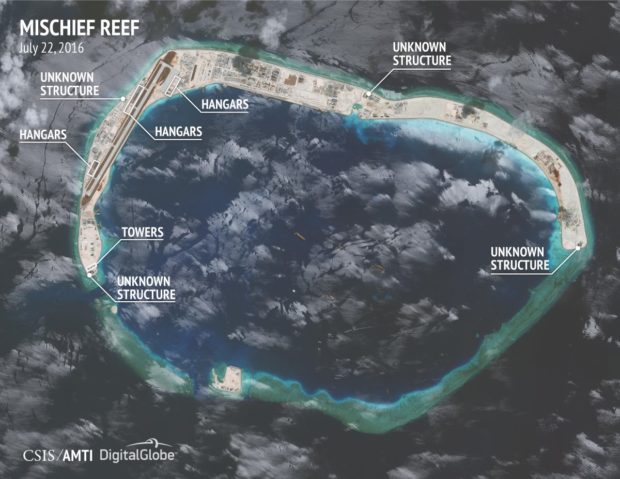HO CHI MINH CITY — The United States seems to be taking a stronger stance against China’s activities in the South China Sea, according to Dr. Ha Anh Tuan, director of the Institute for Foreign Policy and Strategic Studies (IFPSS) of the Diplomatic Academy of Vietnam.
Among the indications this, Ha pointed out, are the recently implemented Freedom of Investigation Operation (Fonop) implemented by the United States and the meeting between US President Donald Trump and Vietnamese Prime Minister Nguyen Xuan Phuc on May 31.
On May 25, the USS Dewey, a guided missile destroyer of the US Navy, sailed within 12 nautical miles (22.22 kilometers) of Mischief Reef (Panganiban Reef) in the Spratly Islands, where China has built one of its man-made islands. The reef is being claimed by the Philippines, Vietnam, and China.
ADVERTISEMENT
Fonop is meant to counter China’s assertion of de facto control over the South China China, where it has nearly finished building artificial islands and military bases.
“In the first month since Trump came into office, the US strategy towards the South China Sea was not clear,” Ha said in an email interview with the Inquirer. “The latest US Freedom of Navigation Operation campaign in May 2017, however, suggests that Trump’s position towards the South China Sea could be even stronger than the one adopted by Obama administration.”
Ha said the delivery of the six coastal patrol vessels to Vietnam, followed by the meeting between Trump and Nguyen on May 31, showed a stronger support of the US against China’s occupation in the South China Sea.
“All are signs of a US commitment, which Vietnam had feared was waning under President Donald Trump,” he said.
Nguyen went to the US for a three-day official visit from May 29 to May 31, which culminated in his first meeting with Trump at the White House. He is the first head of state in Southeast Asia to meet Trump since the latter’s inauguration this year.
Visiting to the US on Trump’s official invitation, the Vietnamese leader also hoped to boost relationship with the US, Vietnam’s top trading partner despite its withdrawal from the Trans-Pacific Partnership (TPP) deal, the trade treaty which an export-oriented Vietnam would have likely benefited from.
Since diplomatic ties between Vietnam and US normalized 20 years ago, bilateral trade has flourished – reaching $36.3 billion in 2014 and $45 billion in 2016.
But the South China Sea was also on the Southeast Asian leader’s agenda. In a joint statement issued after their meeting, Nguyen and Trump called on all parties to “refrain from actions that would escalate tensions, such as the militarization of disputed features.”
ADVERTISEMENT
In the same statement, Trump assured Vietnam that US would continue to “fly, sail, and operate anywhere international law allows.”
Ha noted that the land reclamation of China in the South China Sea was completed well before Trump’s presidency. This, he said, left the the US with “virtually no option to change that reality.”
China, meanwhile, condemned the US operation, saying the US ship did not ask permission to enter what it claimed to be its territorial waters.
But other claimants in the South China Sea, like Vietnam, were hoping to see more of the US presence in the region “as a way to maintain regional peace, stability and security,” Ha said.
Vietnam and the Philippines, along Malaysia and Brunei, have competing claims with China over the South China Sea.
After his US trip, the Vietnamese prime minister would go next to Japan for an official visit from June 4 to 8 at the invitation of Japanese Prime Minister Shinzo Abe.
A meeting between President Rodrigo Duterte and Trump is also in the offing, as the US president had invited the Philippine leader to visit the White House.
Trump is also expected to visit Vietnam in November for the Asia Pacific Economic Cooperation summit to be held there in Danang. /atm
Read more: http://globalnation.inquirer.net/157705/us-taking-stronger-stance-in-south-china-sea-vietnamese-expert#ixzz4jEvR4aMr
Follow us: @inquirerdotnet on Twitter | inquirerdotnet on Facebook

No comments:
Post a Comment